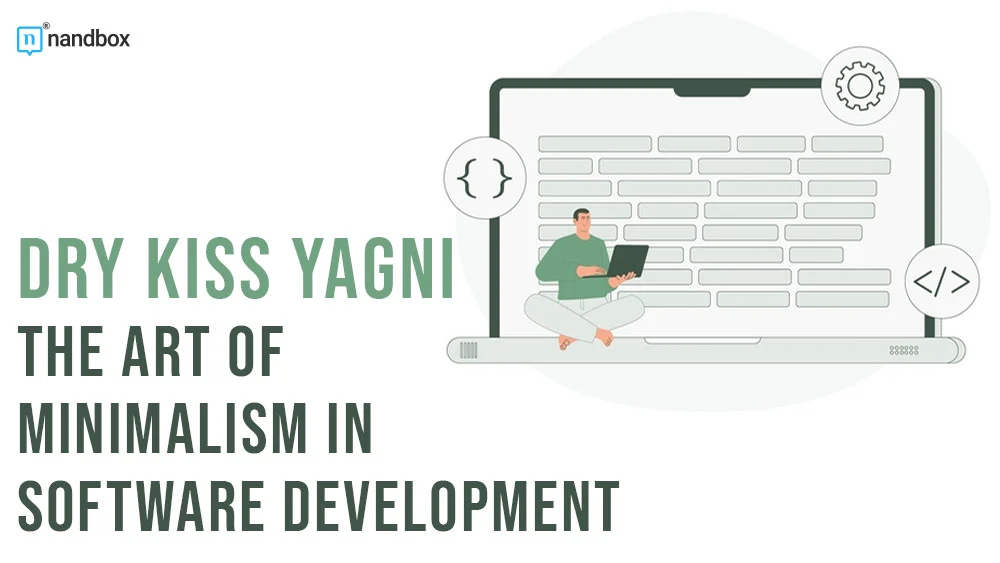People tend to learn from everything going on around them. They seek knowledge and guidance from everything, whether it is a book, a place, a person, and so on. Getting clear and genuine guidance is what makes people become better and also do better. This can be applied to all aspects of life. And well, there is this special group of people that really need endless and ongoing guidance. These would be software and application developers. The development process is one of a kind, but it is also very complex. Therefore, they tend to search for anything that would assist them through this process. The ultimate source of guidance for developers in this case is software development principles. In this article, we will explore four software development principles: DRY, KISS, YAGNI and WET.
We will learn how they help developers maintain a stable and effective process. We will also explore the main principles used by all developers and the pros and cons of each one.
What Are the Software Development Principles?
When starting any process, having guidelines is a must. This is because guidelines act as the foundation of the process and pave the way for stable and effective progress that might be hard to establish without them. When it comes to software or any digital product development, guidelines are lifesavers. Given the complexity and depth of such processes, they require much time, effort, expertise, and so on. In the software and development realm, these guidelines are called software development principles.
Software development principles are a blueprint or a set of policies that help assist developers through the whole process to yield the most effective and successful outcomes. These outcomes include practical code, features, designs, and so on. All of which would provide users with an exceptional experience. The recent and rapid democratization of software helped people discover software development principles to help them understand the process better.
There are a huge number of software development principles that millions of developers rely on. But we will focus on the most important ones, which are DRY, KISS, YAGNI and WET
KISS: A Great Band, A Great Software Principle
Some know KISS as an amazing rock band. Rock and roll all night! However, for software developers, KISS is much more of a rock band; it is a significant principle. KISS is a shortening for “Keep it simple, stupid. As much as this phrase might seem silly or, quote, unquote, foolish, it is actually very clever.
The KISS software principle embraces simplicity as its first and foremost purpose. It includes keeping all parts and elements of the software as simple as possible. This involves features, codebase, infrastructure, design, layout, and so on.
The simplicity of this principle is claimed to achieve great outcomes, such as enhancing flexibility, usability, and reliability.
One of the most popular examples of software that follows this principle is Apple. Apple, with all its products, software, and apps, follows the KISS principle wholeheartedly. If you take a close look, every part and element of Apple’s software and products lacks any complexity. It is straightforward and clear, which makes it a fan favorite and user-friendly.
Advantages and Challenges of KISS Principle
Advantages:
Ease of Understanding
Developers have an easier time comprehending designs that are straightforward, which shortens the learning curve for new development teams or developers. This results in improved efficiency for both maintenance and bug fixing.
Reduced Complexity
There is a strong correlation between simplicity and reduced complexity, which ultimately results in code that is cleaner and easier to maintain. When there are fewer lines of code, there is also less potential for errors.
Faster Development
Designs that are kept simple can be put into action more rapidly. Developers spend less time attempting to understand sophisticated logic and navigate complicated structures.
Scalability
The reduction of complexity in software frequently results in increased scalability. When there is a requirement to scale horizontally or vertically, it is easier to do so with components that have fewer moving elements.
Better User Experience
The adoption of simple designs can result in experiences or interfaces that are easier to understand and more welcoming to users. Users find it much simpler to browse and comprehend technologies that are simple and clear.
Challenges:
Oversimplification
An excessive focus on simplification could result in oversimplification. This would result in the absence of important features or functions that are needed by users or the system.
Balancing Simplicity and Functionality
Maintaining a straightforward approach while simultaneously satisfying every need can be a tough balancing act to pull off successfully. It takes considerable effort to incorporate new features without sacrificing the ease of use of the software or application.
Future Compatibility
An overly straightforward system may find it difficult to adapt to new features or upgrades in the future, particularly if the straightforwardness of the system’s design initially sacrificed its flexibility.
DRY: Bad For Food, Good for Software
Well, as they always say, it is better to be dynamic than to repeat yourself. Well, this principle thinks so too. The DRY principle is another essential software principle that many developers follow. Sometimes DRY can indicate a bad thing, like a dry sandwich that you get from somewhere vague and regret later because it feels like munching on sand. But with software development, DRY indicates dynamism. DRY is an acronym for “don’t repeat yourself,” just like KISS. But how does DRY work as a software development principle like KISS and YAGNI? Let me tell you!
As you know, any software or application is made up of an infrastructure and a codebase. These comprise all the elements and files that make up software and applications.
There is a common wrongful practice among developers, which is code duplication. It usually happens when some developers try to reuse code in different functions but tend to duplicate, or when developers try to save time with development and keep duplicating codes everywhere in the codebase and infrastructure.
This practice is the reason why the DRY principle exists, and it aims to eliminate it completely. The DRY principle emphasizes singularity among codes and encourages avoiding duplication in any part to keep a stable and well-maintained codebase and application.
Advantages and Challenges of the DRY Principle
Advantages:
Consistency Across the System
The adoption of DRY programming practices encourages the use of unified frameworks and logic. This helps to ensure that the codebase as a whole behaves and is implemented consistently. Because of this consistency, both understanding and maintenance become easier.
Enhanced Testing

Testing can be done more effectively when code is reused. Controlling the functionality makes testing easier and more thorough, allowing for the coverage of more system components with fewer tests.
Simplified Debugging
When errors do arise, maintaining just one source or code for a particular piece of functionality cuts down on the amount of time needed to locate and resolve the problem. The debugging efforts are now more targeted, which has increased their effectiveness.
Challenges:
Maintenance of Abstractions
A code with an excessive level of sophistication could be difficult to maintain. Any modifications made to a component that is heavily reused have the potential to have unforeseen effects on other parts of the system and therefore require careful study and testing.
Initial Development Time
When opposed to writing specific code that isn’t reusable, the first stages of creating reusable codes can take significantly more time. This delay in terms of the time needed for development needs to be taken into consideration.
WET Principle: It is Raining Clean Codes
Now that we have talked about DRY, let us discuss the complete opposite. You can find the dry desserts, and you can also find the soaking rainforests. We always see variations, not only in nature; they exist in software as well. As we discussed earlier, the DRY principle is the practice of achieving uniqueness and avoiding code duplication by representing every single function or logic with a specific code. Therefore, maintain clean code and avoid duplication.
Well, what if duplication is needed? What should we do in this case? Easy; follow the WET principle.
WET or write everything twice, is a principle that involves implementing the same code for different elements or in different places. It is used commonly in UI design.
In the WET principle, you will take every single word and purpose of the DRY principle and turn it 180 degrees. This is because the WET principle encourages duplicating code to achieve an easy and simple development process.
Advantages and Challenges of WET Software Principle
Advantages:
Immediate Implementation
By reducing the effort and investment required to construct reusable elements and codes, duplicating code can help speed up the initial development process. This is especially true for smaller-scale projects or prototypes that are developed quickly.
Isolation of Changes
It is possible to mitigate unexpected consequences by having separate and duplicate lines of code. This can prevent changes made to one section from impacting other parts of the code.
Simplicity for Smaller Projects
When it comes to really straightforward applications or software, the time and effort required to create reusable components might not be worth it. In these kinds of situations, it’s possible that duplicating the code will be easier.
Challenges:
Maintenance Overhead
There is a higher chance of inconsistencies and more time spent on maintenance with duplicated code. This is because it must be modified and bug fixes must be tailored to each case individually.
Reduced Flexibility and Adaptability
It may be more challenging to update numerous duplicates of a system when new requirements or features are added, reducing the system’s flexibility.
YANGI: It Might Sound Like an Anime Name, but It is Not
Lastly, on the KISS, DRY comparison comes the YAGNI principle, which, in my opinion, has the coolest name (aka abbreviation) ever. YAGNI is another principle that promotes simplicity and maintains a straightforward software development process. However, it goes another way than the KISS principle.
YAGNI is an acronym for you aren’t gonna need it, but how come we are not going to need something in the development process? Let me tell you how.
Some developers aim to gain a competitive edge with their software and applications in any way possible. One of the ways they tend to do this is by adding as many features and elements as possible. This happens in many cases and even always tends to cause more problems than benefit people. And that is what the YAGNI principle aims to accomplish.
The YAGNI principle encourages only working on features, functionalities, and elements that you really need and would add value to users in the future. This means overlooking any additional feature or function, as long as they are unnecessary, of course.
Advantages and Challenges of YAGNI
Advantages:
Focus on Essential Features
YAGNI proposes that developers pay attention to the needs of the current stage of a project and make sure that the features they incorporate are absolutely crucial to that iteration. In doing so, they can keep their codebase minimal and efficient.
Reduced Complexity
Avoiding feature implementations before they are complete keeps the codebase compact and manageable. YAGNI makes it simpler to understand and scale in the future and simplifies maintenance and alterations later on.
Flexibility and Adaptability
YAGNI gives you a greater capacity to adapt to an ever-shifting environment. Keeping the software flexible and responsive to changing needs requires avoiding commitments to unnecessary functionality upfront.
Challenges:
Complexity of Integration
Putting off the implementation of some features may make their eventual incorporation more difficult. This may necessitate more time spent on development or provide new technological obstacles.
Balancing Simplicity and Completeness
It is essential to find an appropriate balance between simplification and inconsistency. Simplifying the software too much could reduce its value, while adding too much complexity could slow down its uptake.
Limited Vision
It’s possible to miss out on possibilities or show a lack of vision for the software’s and users’ changing needs if desirable additions aren’t implemented right away.
In Summary
In conclusion, as much as the presence of software development principles can be overlooked and appear unimportant at times, it really makes a huge difference. Having a clear idea about what to do and how you would do it can have magical impacts as it maintains a simple process. With a rich list of principles that includes DRY, KISS, YAGNI, WET, and even more, developers can definitely find what is best for them.
It is crucial to strike a balance between these principles. While DRY advocates for reusing code, KISS stresses keeping things simple, YAGNI concentrates on what’s truly necessary, and WET recommends taking a moderate approach to abstraction. Each project requires a tailored strategy that takes into account all of its unique components. Now that you know DRY, KISS, YAGNI and WET in detail, only you can have the final say in which will suit your software.







